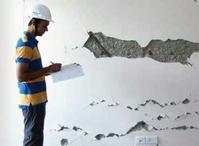Post-Earthquake Reconnaissance in Kathmandu
The catastrophic April 2015 earthquake in Kathmandu, Nepal, offered Prateek Shah a rare opportunity as an engineering student — a research experience related to his interest field that would also help his hometown.
During the summer of 2015, Shah, then a junior in civil engineering, participated in the Summer Undergraduate Research Fellowship (SURF) Program under the guidance of Santiago Pujol, associate professor of civil engineering. The primary goal of their research project was to carry out damage assessment surveys of reinforced concrete buildings in Kathmandu, considered to be one of the most seismically vulnerable cities in
the world, following the magnitude 7.8 earthquake.
It caused more than 8,500 deaths and left more than 22,000 people injured. Another major earthquake of magnitude 7.3 occurred in Nepal on May 12, 2015. Thousands of buildings were destroyed and many more rendered unsafe.
"We wanted to gather data on building performance," Pujol says. "Every earthquake causes tragic losses, but they also generate opportunities to learn to avoid such losses."
Shah, who plans to specialize in earthquake engineering, says, "This research gave me a once-in-a-lifetime opportunity to study and analyze the extent and nature of damage caused by major earthquakes. This invaluable experience enabled me to connect theory to practice."
In seismically active cities like Kathmandu, there often exists a need to assess the seismic vulnerability of a large number of poorly designed buildings within a short period of time. Traditional analysis techniques
are ineffective because they require building data that are either inaccurate or unavailable.
Shah and Pujol tested an alternate analysis technique, the Priority Index, which uses simple correlations involving basic building information to estimate the seismic vulnerability of a building. Their research results showed a good correlation between vulnerability estimates and observed damage, which suggests the Priority Index can be used as a rapid and cost-effective analysis tool for earthquake-prone cities.
"This project exposed several young engineers to an experience that cannot be replicated in the classroom or the laboratory," Pujol says. "Eagerness to learn does not always manifest itself in such a clear way as it did in Kathmandu."
According to Shah, "Apart from gaining technical knowledge, perhaps what I enjoyed the most about the survey was the opportunity to witness firsthand the human facet of engineering as I interacted with a lot of people who had been directly affected by the earthquake. I learned that what we do as engineers has a very pronounced effect on society."


